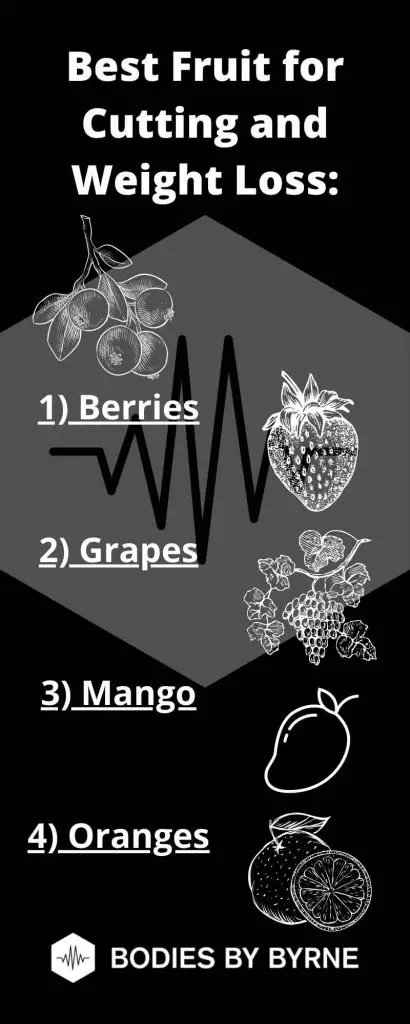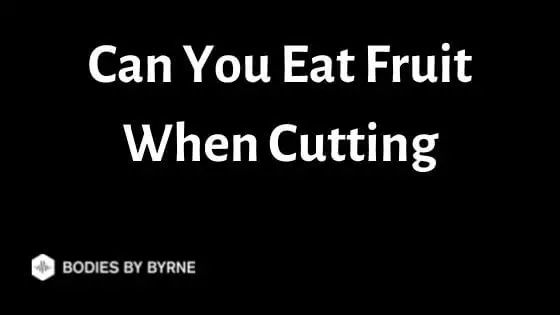Cutting is difficult. Having to focus on tracking your calorie intake and having an overall calorie deficit means that your food choices are drastically reduced.
Even healthy foods may have to be reduced or eliminated when cutting as they can be high in calories. One type of healthy food that we’re often asked about is whether or not you can eat fruit when cutting.
Overall, fruits are a good choice when cutting as they’re often low in calories whilst being nutrient dense. However, it does depend on the fruit. Some fruits are calorie dense, so they’re not a good choice when cutting.
Can You Eat Fruit When Cutting?
You can eat fruit when cutting. However, some fruits like avocados are high in calories. This high-calorie content means that most people shouldn’t eat them when cutting. Instead, they should focus on lower calorie fruits like berries which will make it easier to maintain a calorie deficit.

As well as being low in calories, fruits are also a good option when cutting as many fruits are high in fiber.
Whilst calories are the main focus when cutting, another factor to consider is how filling foods are, also known as satiety. How filling a food is depends on its fiber content with high fiber foods leaving you feeling fuller for longer.
Related – Hungry when cutting (and how to prevent it)
When consuming a calorie deficit you don’t want to be hungry all the time so you need to prioritize high fiber foods that will leave you feeling fuller for longer. As many fruits are high in fiber, this makes them a food choice when cutting.
What are Fruits?
Fruits are a food that comes from trees or other plants that have seeds. There are a wide variety of fruits available in most grocery stores – from apples and bananas to dragon fruits and pineapples.
Due to the huge variety of fruits available, it’s difficult to talk about them collectively. But in general fruits are a great source of essential vitamins and nutrients. Although it varies by fruit, these vitamins and nutrients have a range of health benefits.
Given their health benefits, it’s not surprising that it’s recommended you consume fruit everyday.
It’s arguably even more important to have fruits in your diet when cutting because your body is already working with a reduced amount of calories, so supplying it with these key nutrients and vitamins is essential!
However, despite the benefits of fruits they sometimes get a bad reputation because they’re high in carbs due to their high sugar content.
Some fruits are also high in calories and fats. As I’ll go on to explain, fruits vary significantly in their calorie content, so when cutting it’s important to pick the right fruits.
Fruit Calories
Per 100g, the nutritional value of these three popular fruits are:
| Avocado | Oranges | Raspberries | |
| Calories (kcal) | 160 | 47 | 53 |
| Protein (g) | 4 | 1 | 1 |
| Fat (g) | 30 | 0.12 | 0.7 |
| Carbs (g) | 17 | 12 | 5 |
As you can see, the calorie content of these 3 different fruits varies considerably and so does the protein, fat, and carb content. I purposefully chose these 3 fruits because they show how widely different the different varieties of fruit are when it comes to calories.
Some fruits, like avocado, are calorie dense meaning that they have a high-calorie content per 100g when compared to other fruits. At the other end of the scale are fruits like raspberries which are pretty low in calories per 100g.
How to Eat Fruit When Cutting
When cutting, counting every calorie is important and you want to be as sparing as possible to make sure you maintain an overall calorie deficit.
But you should still incorporate fruits into your diet given that they contain essential nutrients and vitamins which play an important role in your overall health.
So, as a first recommendation, I’d suggest eating the lower-calorie fruits.
As shown in the table above, different fruits come with different calorie contents. High-calorie fruits include avocados, figs, dates, and raisins. Low-calorie fruits include raspberries, mangos, strawberries, and grapes.
By focusing on lower-calorie fruits, you’re still getting those crucial vitamins and minerals without the high-calorie content. This will make it easier to maintain a calorie deficit when cutting.
Another thing to think about is serving size. Taking an avocado as an example, whilst 100g is around 160 calories one whole medium avocado is actually 250 calories. So it’s important to watch your serving sizes and calculate your calorie consumption based on the total amount you’re eating.
It’s also important to think about how often you’re eating fruits. Although it’s recommended that you eat fruits and vegetables every day, if you’re regularly consuming higher calorie fruits then this could undermine the results you want to see from cutting.
So, I’d recommend only having two servings of lower-calorie fruits each day. This way you’re getting the essential vitamins and nutrients, without adding a significant amount to your daily calorie intake.
Also, don’t forget to include fruits within your total calorie count each day. Just because they’re healthy foods doesn’t mean they won’t add to your calorie intake!
You’ll need to adjust your diet to factor in these calories and ensure that you maintain an overall calorie deficit if you want to see results from cutting.
A good way to consume fruit when cutting is to combine it with other nutrient-dense and macro-friendly foods. Different textures, flavors, and macronutrient splits are all important aspects of controlling hunger and cravings when cutting.
Berries for example go well with Greek yogurt or oats for a more filling snack (or breakfast). Fruit smoothies are also a good way to get a sweet snack throughout the day without having to resort to chocolate or other sweet snacks.
Final Thoughts
Fruits can be a great option when cutting. Fruits that are low in calories are the best choice, as they won’t add a huge amount to your calorie intake but they’re filling and nutrient dense which makes them ideal when cutting.
However, try to avoid higher-calorie fruits when cutting. Although these foods are healthy, they’ll make it harder to cut because they’re adding a noticeable amount of calories to your daily intake.
Other factors to consider when eating fruits whilst cutting are serving sizes and frequency. It’s important to have the right serving sizes and to not eat fruits too often if you want to see results from cutting.
It can be hard deciding not only what you can eat when cutting but also what you should eat, therefore, check out some of our other guides below to help:
Can you eat honey when cutting
Can you eat protein bars when cutting
Can you eat butter when cutting
